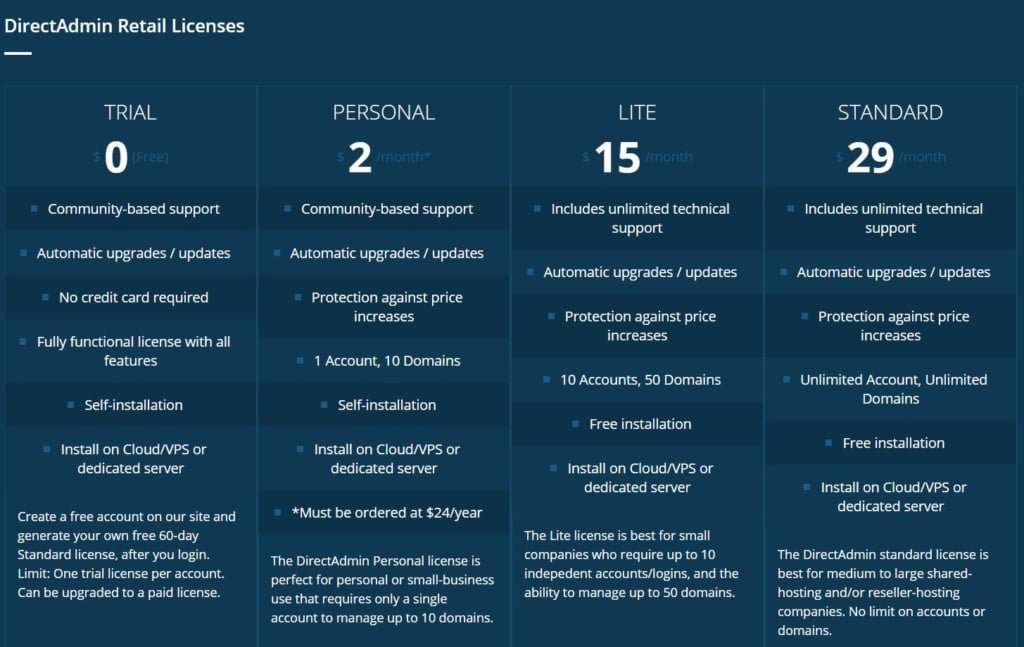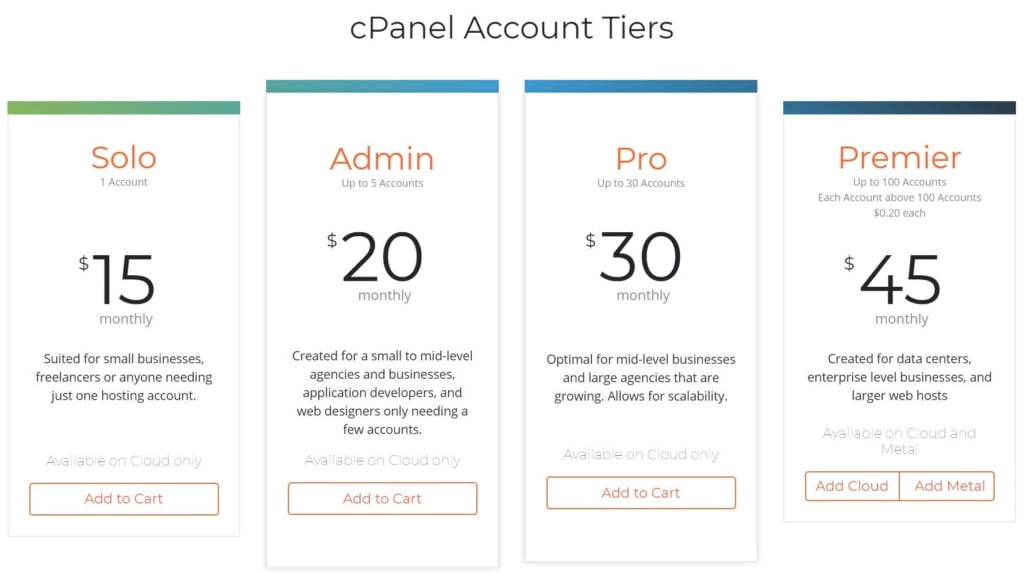DirectAdmin vs. cPanel
With the recent price increases for cPanel licences, there has been a lot of chatter on various hosting forums regarding alternatives, so today I thought I’d take a look and see what else is out there for those of you that may be considering looking for an alternative.
There seems to be three main contenders when it comes to a control panel for your dedicated server, the widely known cPanel as well as Plesk and DirectAdmin.
With Plesk and cPanel now both owned by the same parent company, I have decided to focus this comparison on the pros and cons of DirectAdmin Vs. cPanel.

DirectAdmin offers a range of general features as well as additional features that are specific to their standard access levels, being Admin, Reseller, and User. There is also an additional fourth access level of Email supported which can be added using the official free plugin.
The General Features DirectAdmin has to offer are listed out as being:
- Integrated Ticket Support System
With DirectAdmin’s integrated ticket support system, you’ll provide better customer service with less hassle. “You have XX messages waiting” is displayed every time you sign in — and you can set DirectAdmin to notify you of support requests by e-mail, ensuring that no request will be missed. If you prefer to offer support in a different way, simply turn this feature off. - Two-Factor Authentication
Allows any DirectAdmin account to require the Two-Factor Authentication using a time-based code from a smart-phone app. - Plugin System
Allows to extend DirectAdmin functionality easily. Plugins support Admin, Reseller and User levels. - Live Updates
Server administrators can click the “licensing / updates” button to view the current license and version status. There is no need to manually download, extract, and install – DirectAdmin performs all updates automatically. - Completely Customizable
DirectAdmin is designed to be as unique as your business. Every aspect of the DirectAdmin interface can be changed, and new designs are easily imported through the “skins” menu. - Automatic Recovery From Crashes
DirectAdmin TaskQueue ensures that all services are up, all of the time. If something crashes, DirectAdmin will attempt to fix the problem by restarting the service. If this fails, DirectAdmin will notify the server administrator immediately. - Customer Support Through Site-Helper
Site-Helper is designed to help you and your customers use DirectAdmin. We provide full instructions on every DirectAdmin feature, along with plenty of pictures and examples.
After that, the features become much more customised to be end user specific, depending on which role you will be using when you interact with DirectAdmin. We’ll look at those features now.
Aimed at the end users of the service, the ‘User Level’ features DirectAdmin are offering are listed out as follows:
- E-mail Administration
Users can create POP/IMAP accounts, catch-all e-mail addresses, forwarders, mailing lists, autoresponders, and webmail. Filters allow users to block mail by domain, keyword, and size. Adult Filter is also available. - FTP Management
Users can create FTP accounts and set directory permissions for each account. Anonymous FTP is also supported. - DNS Menu
Users can can add and remove records, change MX settings, and anything else that goes with full DNS control. - Statistics Menu
Users have available every possible statistic about their account. More advanced options and Webalizer are also included. - Subdomains Menu
Users can list, create, delete, and get statistics on subdomains. - File Manager
A user-friendly and fast alternative to FTP. Includes every feature needed to build and maintain a web site. - MySQL Databases
Users can easily create, modify, and delete MySQL databases from this menu. - Site Backup
Using this powerful tool, users can backup and restore only what they want to. For example, account data but not web site files. - Error Pages
Users can create custom messages and outputs for 401, 403, 404, and 500 error codes. - Directory Password Protection
Users can password protect any directory with a username and password. - PHP Selector
Allows the client to select which version of PHP should be associated with the .php extension. - Advanced Tools
Users can install SSL certificates, view sever information and installed perl modules, set cron jobs, mime types, and apache handlers, and enable site redirection and domain pointers.
The next tier of features is the Reseller, and the features offered for ‘Reseller Level’ are as follows:
- Create / List / Modify Accounts
Account creation, listing, modification, and deletion is done quickly and easily. - User Packages
Resellers can create predefined account packages using this feature. When creating an account, the reseller simply chooses a package instead of manually setting each account feature. - Reseller Statistics
Resellers are provided with a complete overview of their total usage. Resellers may also sort data by users to quickly assess the overall situation. - Message All Users
Resellers can quickly send a message to all their customers by using DirectAdmin’s built in ticket support system. - Import / Manage Skins
With this menu option, resellers can quickly import and apply new skins with the click of a button. - IP Assignment
Resellers can allocate IP address to their customers by using this menu option. - System / Services Information
By clicking this feature, resellers have instant access to server status and system information. - Name Servers
Resellers can create personalized nameservers for their customers from this menu.
The topmost tier of DirectAdmin features is the server ‘Administration Level’ which offers the following additional features:
- Create / Modify Admins and Resellers
Admins can create resellers or extra admins quickly and easily with this feature. - Reseller Packages
Admins can create predefined account packages using this feature. When creating an account, the admin simply chooses a package instead of manually setting each account feature. - Show All Users
This feature allows the admin to quickly view every single account on the system and sort this list in various ways. - DNS Administration
This feature allows the admin to create, modify, or delete any DNS records on the server. - IP Manager
This is where the admin sets the IP address available to the server. The admin can also allocate IP address to resellers from this menu. - Mail Queue Administration
Tool to view mail queue and it’s messages. Includes tools to take action on those messages. - System / Services Info
The admin can view, stop, start, and restart services from this menu. - Complete Usage Statistics
This feature provides the admin with a complete overview of system usage. Exact input and output from the server’s Ethernet card is also monitored. - DNS Clustering
DirectAdmin talks to other DirectAdmin machines to automatically transfer DNS data between them. It also has the ability to check the other server for a domain so as to not allow duplicate domains on your DA network. - SPAM fighting tools in DirectAdmin
A wide varienty of SPAM-fighting tools are provided with DirectAdmin. - Licensing / Updates
The admin can view his or her license status and download the latest DirectAdmin security and software upgrades from this menu.
Conveniently DirectAdmin also offers an interactive demonstration on their website for each of the different user levels so you can take a look. You can find the interactive demonstrations here: https://www.directadmin.com/demo.php
So that’s the features that DirectAdmin states that they offer, but in a direct side by side comparison, how does DirectAdmin compare, features wise, against cPanel?
Now, while this list is in no way an extensive list of all comparable features, it does have what could be considered some of the most important features to take into account:
| Resellers | cPanel | DirectAdmin |
| Configurable reseller hosting packages | YES | YES |
| CSS-brandable reseller experience | NO | YES |
| Brand Experience | cPanel | DirectAdmin |
| CSS-based theme system | NO | YES |
| Multiple language packs | YES | YES |
| Time Saving | cPanel | DirectAdmin |
| Fast, RPM-based installation | ~35 MIN | N/A |
| Database | cPanel | DirectAdmin |
| Manage MySQL databases, users, & permissions | YES | YES |
| phpMyAdmin integration | YES | YES |
| PostgreSQL Support | YES | NO |
| Email, Spam, & Viruses | cPanel | DirectAdmin |
| Configurable mailboxes, forwarders, quotas | YES | YES |
| Configurable spam filtering | YES | YES |
| E-mail virus protection | YES | LIMITED |
| Domainkeys (DKIM) & SPF records | YES | YES |
| Global white & black lists | YES | YES |
| Troubleshooting | cPanel | DirectAdmin |
| Log Viewer | YES | YES |
| Secure Remote Assistance Feature | YES | NO |
| Graphical Real Time Usage Statistics | LIMITED | LIMITED |
| Scalability Features | cPanel | DirectAdmin |
| External DNS syncronization | YES | NO |
| Supporting Software | cPanel | DirectAdmin |
| DNS | BIND | BIND |
| EXIM | EXIM | |
| Firewall | CSF | IPTABLES |
| Security | cPanel | DirectAdmin |
| Avg. days to acknowledge an exploit | 9 | 0 |
| Avg. days to resolve an exploit | 28 | 64 |
Ultimately, DirectAdmin and cPanel are very similar, yet they do have important differences, functionally and cosmetically.
From a functionality perspective, they both provide a server configuration framework and UI, but DirectAdmin leaves quite a bit of the work to be done in the root shell.
cPanel, on the other hand, provides nearly all the configuration and functionality within the UI. This makes it far easier to use and a better fit for many user levels. However, advanced users who do want to make changes from the root shell, may find getting these manual changes to “stick” to be more difficult with cPanel.
DirectAdmin is a formidable competitor with an emphasis on the fact that it is a lighter control panel than cpanel which makes it a better choice for servers having limited resources. Also, while DirectAdmin is expandable, the cost of adding additional functionality can be very high.
cPanel is often perceived as being better for beginners with its ease of use, while also providing the customization more advanced users desire. Its easy to use graphical interface and strong third-party developer support means you can add plugins and modules very easily and inexpensively. For example, plugins such as softaculous provide one click installation of wordpress, joomla, drupal etc.
Although functionally, DirectAdmin has been a good cPanel alternative for some time, before the recent cPanel price increases, many people saw it as easier to stick with what they knew rather than consider alternatives.
In the current market, with such large increases in price for cPanel, people are taking a second look at DirectAdmin. As price is the biggest factor driving this shift, let’s take a look at how the costs of the two control panels compare.
DirectAdmin end user pricing starts from $2 /mo for a single domain license, up to $29 / mo for an unlimited accounts license:

While prices for a comparable single-account cPanel end user licence starts at $15 /mo, with 100 accounts costing $45 / mo, and there not being any unlimited accounts option:

I’ve mentioned “end user price” twice now. What that means, the cost the user of the license would pay, buying the license directly from the developer of the software. Another license type is a “datacenter license”, which offers lower prices for companies that rent dedicated servers or VPS’s to end users. In these cases, a typical 200-account cPanel license is over $30 / mo, while an unlimited-account DirectAdmin license is typically under $15 / mo. For servers with over 200 accounts, the price difference grows, as cPanel continues to cost more, while DirectAdmin costs remain fixed.
What does all that mean?
In summary, your preference for one brand of hosting control panel software over another will always be subjective and dependent on what best suits both your budget your needs. With that in mind, DirectAdmin is definitely a viable contender worthy of consideration.
** All prices apply to licences purchased directly online from https://www.directadmin.com/pricing.php or from https://cpanel.net/pricing/ — Prices are accurate as of September 30, 2019 but may be subject to change.


